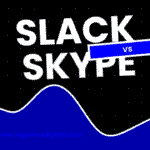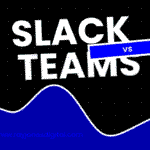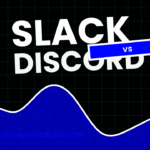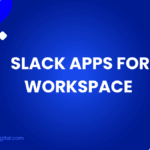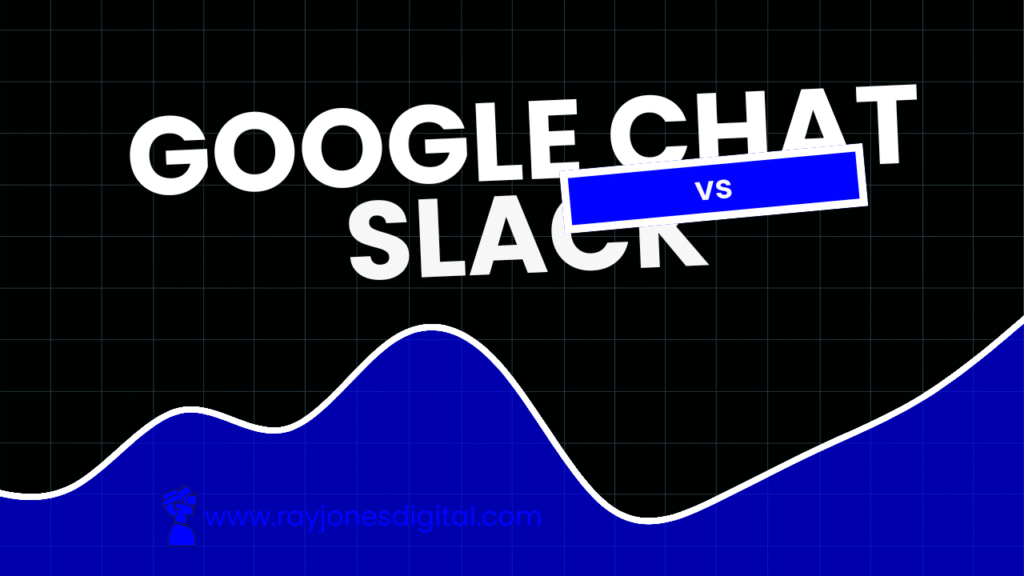
Team messaging has become the backbone of modern workplace communication, with platforms like Google Chat vs Slack leading the charge. Both promise to streamline collaboration, reduce email overload, and keep teams connected—but they approach these goals differently.
Google Chat integrates seamlessly with Google Workspace, offering a unified experience for teams already using Gmail, Drive, and Calendar. Slack, meanwhile, has built its reputation on robust messaging features, extensive customisation, and a thriving ecosystem of third-party integrations.
This comprehensive comparison examines both platforms’ features, pricing, user experience, and suitability for different team sizes and workflows. By the end, you’ll understand which platform aligns best with your organisation’s communication needs and working style.
What is Google Chat?
Google Chat evolved from Google Hangouts as part of Google’s broader push to create professional-grade communication tools. Launched in 2018, the platform integrates natively with Google Workspace, creating a unified environment where teams can message, share files, and collaborate without switching between applications.
The platform emphasises simplicity and integration over complex features. Users can start conversations directly from Gmail, share Google Drive files with a single click, and schedule meetings through Google Calendar without leaving the chat interface. This seamless integration makes Google Chat particularly attractive for organisations already invested in Google’s productivity ecosystem.
Google Chat supports both direct messaging and organised team conversations through Spaces (formerly Rooms). These dedicated areas allow teams to collaborate on specific projects, share resources, and maintain ongoing discussions around particular topics or departments.
What is Slack?
Slack pioneered the modern team messaging category when it launched in 2013, transforming how teams communicate and collaborate. The platform moved workplace communication away from email towards organised, searchable conversations that could span entire organisations or focus on specific projects.
Slack’s strength lies in its flexibility and extensive customisation options. Teams can create channels for different topics, departments, or projects, whilst powerful search functionality helps users find past conversations and shared files. The platform’s threading system keeps discussions organised, preventing important messages from getting lost in busy channels.
The platform has evolved beyond simple messaging to become a comprehensive collaboration hub. With over 2,000 third-party integrations, Slack connects with virtually every business tool, from project management systems to customer support platforms. This extensibility makes Slack adaptable to diverse workflows and business requirements.
Key Features Comparison
Messaging and Communication
Google Chat provides straightforward messaging with support for direct messages, group conversations, and organised Spaces. The platform includes basic formatting options, emoji reactions, and file sharing capabilities. Messages integrate with Google’s powerful search technology, making it easy to find past conversations and shared content.
Slack offers more sophisticated messaging features, including threaded conversations, message formatting with markdown support, and extensive emoji customisation. The platform’s channel structure allows for better organisation of team discussions, whilst features like message reminders and scheduled sending provide additional workflow control.
File Sharing and Collaboration
Google Chat excels at file sharing within Google’s ecosystem. Users can share Google Drive files directly in conversations, collaborate on documents in real-time, and maintain version control automatically. The platform also supports file uploads from local devices, though these integrate less seamlessly than Google Drive content.
Slack provides comprehensive file sharing capabilities with support for various file types and external cloud storage services. The platform includes built-in document previews, version history, and commenting features. However, real-time collaboration on documents requires third-party integrations with tools like Google Workspace or Microsoft Office.
Search and Organisation
Google Chat leverages Google’s search expertise to provide powerful conversation and file search capabilities. Users can search across all messages, shared files, and even content within Google Drive documents. The platform’s search results are comprehensive and fast, making it easy to locate specific information across team communications.
Slack’s search functionality is equally impressive, with advanced filters for finding specific messages, files, or conversations. The platform allows users to search within specific channels, from particular team members, or within date ranges. Slack’s search extends to integrated third-party applications, providing a unified search experience across connected tools.
Integration Capabilities
Google Chat’s integration strength centres on Google Workspace applications. The platform connects seamlessly with Gmail, Calendar, Drive, Meet, and other Google services. This integration creates a unified workflow for teams using Google’s productivity suite, though options for non-Google tools remain limited.
Slack boasts one of the most extensive integration ecosystems in the business software space. The platform connects with thousands of third-party applications through its App Directory, including project management tools, CRM systems, development platforms, and analytics services. Custom integrations are possible through Slack’s robust API and workflow automation tools.
Mobile Experience
Google Chat provides a clean, efficient mobile experience that mirrors the desktop interface. The mobile app includes all core messaging features, file sharing capabilities, and seamless integration with other Google mobile applications. Push notifications keep users informed of important messages and mentions.
Slack’s mobile application offers a comprehensive experience with nearly all desktop features available on mobile devices. The app includes advanced notification controls, offline message viewing, and the ability to access integrated third-party tools. Slack’s mobile experience is particularly strong for teams that rely heavily on mobile communication.
Pricing and Plans
Google Chat Pricing
Google Chat pricing aligns with Google Workspace subscriptions, making it cost-effective for organisations already using Google’s productivity tools:
Free Plan: Basic Google Chat functionality with Gmail integration, though with limited storage and features.
Business Starter: £4.68 per user per month, providing full Google Workspace access including Chat, Gmail, Drive, and Meet.
The Business Standard: £9.36 per user per month, adding advanced admin controls and increased storage.
The Business Plus: £15.60 per user per month, including advanced security features and compliance tools.
Slack Pricing
Slack operates on a dedicated messaging platform model:
Free Plan: Limited message history (10,000 most recent messages), basic integrations, and file storage restrictions.
Pro: £5.25 per user per month, providing unlimited message history, guest access, and advanced integrations.
Business+: £9.75 per user per month, adding advanced admin controls, compliance features, and priority support.
Enterprise Grid: Custom pricing for large organisations requiring advanced security and compliance features.
The pricing structures reflect different value propositions. Google Chat comes bundled with productivity tools, whilst Slack focuses specifically on messaging and collaboration features.
User Experience and Interface
Google Chat Interface
Google Chat follows Google’s material design principles, providing a clean, intuitive interface that feels familiar to users of other Google applications. The platform’s sidebar navigation makes it easy to switch between different conversations and Spaces, whilst the main chat area remains uncluttered and focused.
The interface prioritises simplicity over advanced features, which can be both a strength and limitation. New users typically find Google Chat easy to navigate, but power users may miss some of the advanced interface customisation options available in more feature-rich platforms.
Slack Interface
Slack offers a more customisable interface with options for themes, sidebar organisation, and notification preferences. The platform’s three-panel layout (sidebar, message list, and details panel) provides comprehensive information whilst maintaining good usability.
Slack’s interface can initially appear overwhelming to new users due to its many features and options. However, this complexity enables power users to create highly personalised workflows and communication patterns that match their specific needs and preferences.
Performance and Reliability
Google Chat Performance
Google Chat benefits from Google’s global infrastructure, providing reliable performance and fast message delivery worldwide. The platform’s integration with Google’s ecosystem ensures smooth performance when sharing files or switching between applications.
Load times are generally fast, and the platform handles large file transfers efficiently through Google Drive integration. Google Chat’s browser-based approach ensures consistent performance across different operating systems without requiring separate software installations.
Slack Performance
Slack has invested heavily in platform reliability and performance, particularly as it scales to support large enterprise customers. The platform generally provides fast message delivery and efficient file handling, though performance can vary based on the number of active integrations and channels.
Slack’s desktop applications typically offer superior performance compared to browser-based usage, particularly for organisations with numerous active channels and integrations. The platform’s infrastructure handles high-volume messaging well, making it suitable for large, active teams.
Use Cases and Applications
When to Choose Google Chat
Google Chat serves organisations and teams that prioritise integration and simplicity:
- Google Workspace users seeking unified communication within their existing productivity environment
- Small to medium businesses requiring straightforward team messaging without complex feature management
- Educational institutions conducting online collaboration and administrative communication
- Teams prioritising file collaboration with extensive Google Drive usage
- Organisations seeking cost-effective communication bundled with productivity tools
When to Choose Slack
Slack benefits teams requiring advanced messaging features and extensive customisation:
- Technology companies needing robust developer integrations and workflow automation
- Large organisations managing complex communication across multiple departments and projects
- Remote teams requiring sophisticated asynchronous communication tools
- Customer support teams integrating messaging with help desk and CRM systems
- Marketing teams coordinating campaigns across multiple tools and platforms
Limitations and Considerations
Google Chat Limitations
Google Chat’s simplicity can be restrictive for organisations requiring advanced messaging features. The platform lacks some sophisticated communication tools found in dedicated messaging solutions, such as extensive workflow automation and advanced channel management.
The platform’s integration strength becomes a limitation for organisations not using Google Workspace extensively. Teams relying on Microsoft Office or other productivity suites may find the integration benefits less compelling, reducing Google Chat’s overall value proposition.
Slack Limitations
Slack’s feature richness can overwhelm users seeking simple team messaging. The platform’s extensive options may require additional training and ongoing management, particularly for less technical users or smaller organisations.
Cost can accumulate quickly for growing organisations, particularly when adding premium features and integrations. Unlike Google Chat’s bundled approach, Slack’s modular pricing structure may result in higher total communication costs for comprehensive team collaboration.
Security and Compliance
Google Chat Security
Google Chat inherits Google’s enterprise-grade security infrastructure, including encryption in transit and at rest, advanced threat protection, and comprehensive admin controls. The platform meets various compliance standards including GDPR, HIPAA, and SOC 2.
Administrative controls allow organisations to manage user access, set retention policies, and monitor communication patterns. Google’s security team continuously monitors and updates the platform’s security measures, providing regular transparency reports about security incidents and improvements.
Slack Security
Slack has significantly invested in security features, particularly for enterprise customers. The platform provides enterprise key management, data loss prevention, and comprehensive audit logs. Slack meets major compliance standards and offers additional security features for regulated industries.
The platform’s security model includes granular permission controls, two-factor authentication, and integration with enterprise identity management systems. Slack’s security team provides regular updates and maintains transparency about security practices and incident response procedures.
Making the Right Choice for Your Team
Your choice between Google Chat and Slack depends on your organisation’s existing tool ecosystem, communication complexity, and growth plans.
Choose Google Chat if your team already uses Google Workspace extensively and values seamless integration over advanced messaging features. The platform suits organisations seeking cost-effective team communication bundled with productivity tools.

I am Ray Jones Digital
My current occupations: a Digital Marketer, Local SEO expert, Link Builder, and WordPress SEO specialist. Shopify SEO, Ecommerce Store Management, and HTML & WordPress Developer I have been practicing the above mentioned services for more than 10 years now As an SEO expert working with your ongoing projects.
